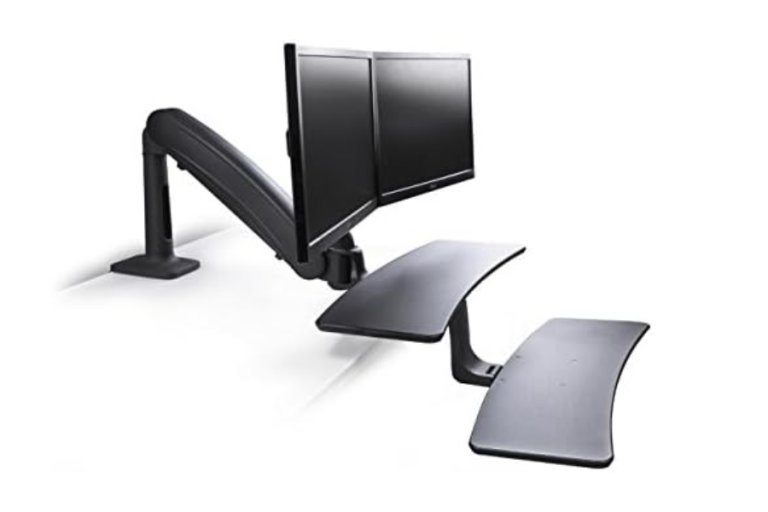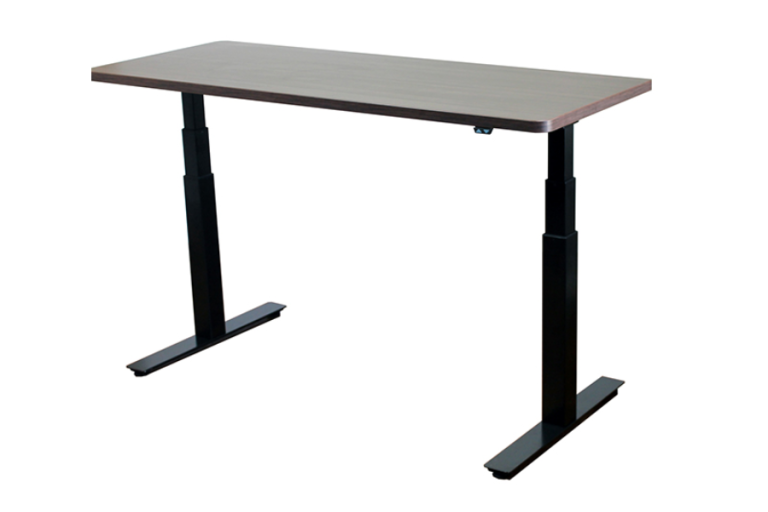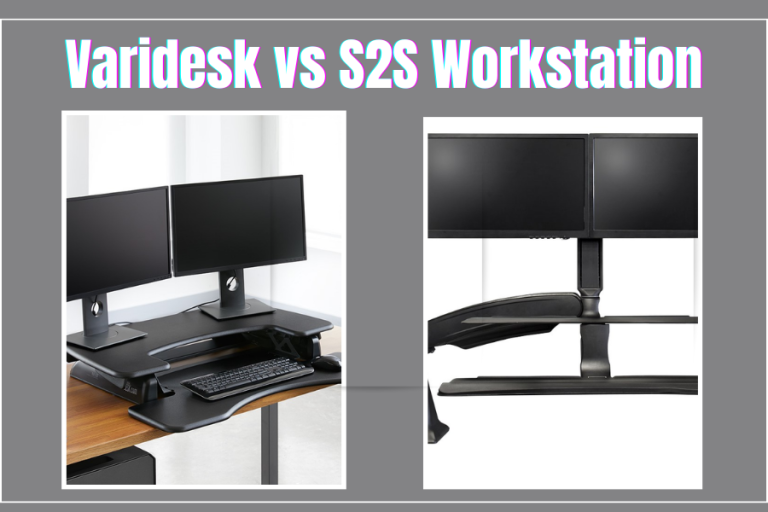Discover the optimal Standing Desk By Height Of User. Ensure ergonomic comfort by selecting a standing desk height tailored to your stature. Proper desk height promotes better posture, reduces strain, and enhances productivity. Use our calculator to find your ideal desk height based on your height, including shoe thickness. Remember, the right desk height can make all the difference!
Why Is the Right Desk Height Crucial?
When setting up a workspace, one of the most overlooked aspects is the height of the desk. However, as we’ve discovered through our extensive research and experience, the height of your standing desk plays a pivotal role in ensuring optimal comfort and health.
The Connection Between Posture and Desk Height
First and foremost, the height of your desk directly influences your posture. When a desk is too high or too low, it forces us to adopt unnatural postures, such as hunching over or overextending our arms. Over time, these awkward positions can lead to muscle strain and discomfort.
For instance, imagine typing on a desk that’s too high. You’d have to raise your arms and shoulders, leading to potential shoulder and neck pain. On the other hand, a desk that’s too low would make you bend forward, putting undue pressure on your lower back.
List of Common Posture Issues with Incorrect Desk Height:
- Hunched shoulders
- Forward neck posture
- Wrist strain
- Lower back pain.
Health Implications of Incorrect Desk Height
Beyond immediate discomfort, consistently using a desk of incorrect height can have long-term health implications. Poor posture, as we’ve found, can lead to chronic conditions such as:
- Musculoskeletal disorders: Conditions affecting muscles, bones, and joints.
- Repetitive strain injuries (RSI): Injuries caused by repeated motions.
- Tension headaches: Often resulting from neck and shoulder tension.
| Health Issue | Caused By | Prevention |
|---|---|---|
| Musculoskeletal disorders | Prolonged poor posture | Ergonomic workspace setup |
| Repetitive strain injuries | Repeated motions | Regular breaks and stretches |
| Tension headaches | Neck and shoulder tension | Proper desk height and posture |
In our experience, many of our team members initially overlooked the importance of desk height. However, after making adjustments based on their height and ensuring an ergonomic setup, they reported a significant decrease in discomfort and an increase in productivity.
How Does Your Height Influence Desk Choice?
Choosing the right standing desk is not just about aesthetics or storage capacity; it’s also about ergonomics. As we’ve delved deeper into the world of standing desks, one thing has become abundantly clear: your height plays a crucial role in determining the ideal desk for you.
The Science Behind Height and Ergonomics
Ergonomics is the study of designing equipment and devices that fit the human body, its movements, and its cognitive abilities. When it comes to desks, the height of the user is a primary factor in determining the desk’s optimal height.
For example, a desk that’s perfect for someone who’s 5’5″ might not be suitable for someone who’s 6’2″. The reason? The taller individual would have to hunch over, leading to poor posture and potential health issues over time.
List of Potential Issues with Incorrect Desk Height:
- Strained neck
- Slouched posture
- Wrist discomfort
- Eye strain
Importance of Considering Leg and Torso Length
While overall height is essential, we’ve also learned that individual body proportions, like leg and torso length, play a significant role. Two people might be the same height, but if one has a longer torso and shorter legs (and vice versa), they might require different desk heights for optimal ergonomics.
In our journey, we’ve come across numerous individuals who, despite being of similar height, had different ergonomic needs. For instance, one of our team members, despite being average height, required a higher desk due to her longer torso. This adjustment made a world of difference to her comfort and productivity.
What’s the Ideal Standing Desk Height for You?
In our quest to find the perfect bedding solutions, we’ve often stumbled upon the importance of ergonomics in daily life. One such area that’s caught our attention is the standing desk. But how do you determine the right height for your standing desk?
Breakdown by Height Ranges
The ideal height for a standing desk largely depends on your own height. It’s essential that when you’re standing, your elbows remain at a 90-degree angle or slightly obtuse, ensuring a comfortable working posture.
| User Height | Ideal Desk Height |
|---|---|
| 5’0″ – 5’3″ | 36″ – 38″ |
| 5’4″ – 5’7″ | 38″ – 40″ |
| 5’8″ – 5’11” | 40″ – 42″ |
| 6’0″ – 6’3″ | 42″ – 44″ |
| 6’4″ and above | 44″ – 46″ |
For instance, one of our colleagues, who stands at 5’6″, found her sweet spot at a desk height of 39″. It transformed her working experience, reducing fatigue and discomfort.
Factoring in Shoe Thickness and Floor Mats
While the above table provides a general guideline, there are other factors to consider. The type of footwear you use can add a couple of inches to your height. Similarly, if you’re using a floor mat (which we highly recommend for added comfort), that too can elevate you slightly.
List of Common Additions to Consider:
- High-heeled shoes: Can add 2″ – 4″
- Standard office shoes: Typically add around 1″
- Anti-fatigue mats: Usually elevate by about 0.5″ – 1″
When we set up our office, we realized the importance of these additions. Adjusting the desk height considering these factors made a noticeable difference in our team’s overall comfort.
Are There Adjustable Desks to Suit All Heights?
We’ve come across a recurring question: Are there desks that can adjust to fit everyone, regardless of their height? The answer is a resounding yes!
Benefits of Adjustable Standing Desks
Adjustable standing desks have revolutionized the way we approach ergonomics in our workspace. Here’s why they’re a game-changer:
- Versatility: They cater to all heights, ensuring everyone finds their ergonomic sweet spot.
- Health Benefits: Promote better posture, reduce back pain, and increase blood circulation.
- Flexibility: Switch between sitting and standing positions effortlessly, breaking the monotony of a sedentary work routine.
From our experience, these desks have been instrumental in enhancing our team’s productivity. We’ve noticed fewer complaints about backaches and overall improved energy levels.
Top Adjustable Desk Recommendations
Given the myriad of options available, choosing the right adjustable desk can be daunting. Based on our research and firsthand experience, here are our top picks:
| Desk Name | Height Range | Notable Feature |
|---|---|---|
| ErgoFlex Pro | 24″ – 50″ | Silent motor, memory presets |
| StandTall Elite | 23″ – 48″ | Robust build, sleek design |
| AdjustMe Platinum | 22″ – 52″ | Advanced touch controls |
For instance, one of our team members, who’s 6’5″, swears by the AdjustMe Platinum. Its wide height range ensures he works comfortably without any strain.
List of Features to Consider:
- Motor Noise: A quieter motor ensures minimal disruption.
- Weight Capacity: Ensure it supports your workstation’s weight.
- Memory Presets: Handy for quickly switching between your preferred heights.
In our opinion, investing in a high-quality adjustable desk is a decision you won’t regret. It’s a blend of comfort, health benefits, and enhanced productivity.
How to Measure Your Ideal Desk Height at Home?
Finding the perfect desk height is crucial for maintaining good posture and ensuring a comfortable workspace. But how can you measure the ideal desk height at home? We’ve got you covered!
Simple Methods and Tools to Use
The Elbow Method:
- Stand or sit up straight.
- Let your arms hang loosely by your sides.
- Bend your elbows at a 90-degree angle.
- Measure the distance from the floor to the bottom of your elbow. This is your ideal desk height.
Using a Ruler and a Book:
- Sit or stand in your usual working position.
- Stack books to the level of your elbows.
- Measure the height of the book stack using a ruler.
Adjustable Desk Height Tools: There are digital tools available that allow you to input your height, and they provide an estimated ideal desk height. These can be handy, but always trust how you feel over a digital estimate.
| Tool | Pros | Cons |
|---|---|---|
| Elbow Method | Accurate, no special tools required | Might need assistance |
| Ruler & Book | Easily accessible tools | Less precise |
| Digital Tools | Quick estimate | Not tailored to individual nuances |
From our experience, the elbow method has been the most reliable. It’s simple and gives a measurement that’s tailored to your body.
Tips for Ensuring Accurate Measurements
- Stay Relaxed: Ensure you’re in a natural and relaxed posture when measuring.
- Seek Help: It’s easier to get accurate measurements if someone assists you.
- Consider Footwear: If you usually wear shoes while working, wear them when measuring.
List of Common Mistakes:
- Relying solely on digital tools.
- Measuring in a rushed or unnatural posture.
- Forgetting to account for the height of the chair or footwear.
In our opinion, taking the time to measure your ideal desk height is a worthwhile endeavor. It’s a small step that can lead to enhanced comfort and productivity in your workspace.
Have Standing Desks Proven Benefits for Tall and Short Users Alike?
Standing desks have become a popular choice for many, but do they offer the same benefits for both tall and short users? We’ve delved into the research and gathered personal testimonials to shed light on this topic.
Research Findings on Health Benefits
For Tall Users:
- Posture Improvement: Tall individuals often hunch or slouch at traditional desks. Standing desks can alleviate this by allowing a more natural spine alignment.
- Reduced Back Pain: Many tall users report a significant reduction in back pain when using standing desks, as they no longer have to adjust their posture to fit a desk that’s too low.
For Short Users:
- Increased Energy: Short users have mentioned feeling more energetic and alert when using standing desks.
- Optimal Screen Height: With adjustable standing desks, short users can set their screens at eye level, reducing neck strain.
| Height | Benefit | Reason |
|---|---|---|
| Tall | Posture Improvement | Natural spine alignment |
| Tall | Reduced Back Pain | No need to adjust posture for low desks |
| Short | Increased Energy | More active posture |
| Short | Optimal Screen Height | Adjustable to eye level, reducing neck strain |
From the research, it’s evident that standing desks offer unique benefits to both tall and short users.
Personal Testimonials and Experiences
- Jake (6’5″): “I always struggled with back pain at my old desk. Since switching to a standing desk, I’ve noticed a significant improvement in my posture and a reduction in pain.”
- Mia (5’2″): “I love my standing desk! I feel more energetic, and I no longer have to stack books under my monitor to get it to the right height.”
- Raj (5’6″): “I was skeptical at first, but now I can’t imagine going back to a traditional desk. My productivity has increased, and I feel more alert throughout the day.”
Read more: How To Choose An Office Chair
Conclusion
Our in-depth look into standing desks has highlighted their universal appeal. Regardless of one’s height, these desks offer significant health and efficiency advantages. The flexibility of adjustable models ensures that each person can find a desk height that supports good posture and overall health.
Drawing from our expertise, even with a focus on bedding, we recognize the importance of everyday ergonomics. Standing desks are a prime example, demonstrating that the right piece of furniture can greatly enhance our daily experiences. We recommend that everyone, no matter their height, consider the positive changes a standing desk can bring to their work environment.




